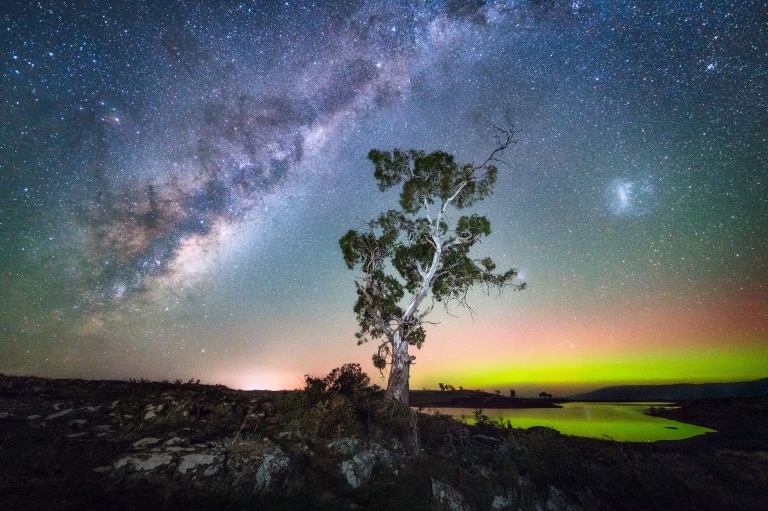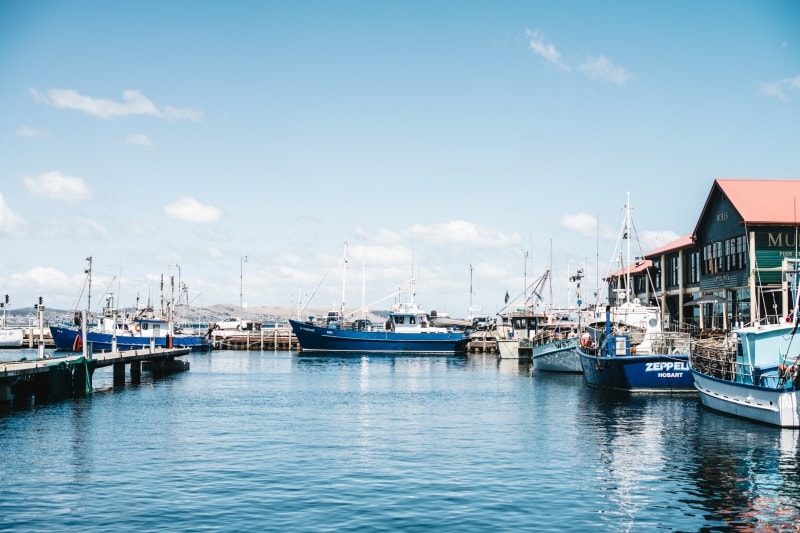
Aurora Australis, Tasmania © Luke Tscharke
Seasonal nature experiences in Australia
Australia’s nature experiences are striking, inspiring - and sometimes elusive. Here are seven worth travelling for.
Staircase to the Moon, Broome
Staircase to the Moon, Broome
On each full moon, something special happens in Broome. As the moon rises, its light reflects off the exposed tidal flats of Roebuck Bay, creating a “staircase” leading up to the moon. The optical illusion is a bewitching sight, with the moon peeking slowly above the horizon. Watch from the Mangrove Hotel’s open-air bar where the lights are dimmed and locals play the didgeridoo. Or, roll out a rug at the nearby Town Beach night markets.
The turning of the fagus, Tasmania
The turning of the fagus, Tasmania
With Australia’s famously sunny summer days, it’s easy to forget that the autumn season brings its own distinct beauty. In Tasmania, you can witness the transformation of a tree from lush green to brilliant reds and golds in what is known as the “turning of the fagus.” Your best bets for getting up close to this colourful display are Cradle Mountain-Lake St Clair National Park and Mt Field National Park.
Bioluminescent plankton, Jervis Bay
Bioluminescent plankton, Jervis Bay
Jervis Bay, a three-hour drive from Sydney, is renowned for its pristine white sand and lush vegetation, but you’ll also find a hidden wonder that’s both bizarre and beautiful. Due to chemical reactions within plankton, the water in Jervis Bay sometimes displays swirls of glowing blue along the shore. This unusual natural phenomenon, which can only be seen at night, can happen at any time of the year but is more common in the warmer months.
Lavender fields, Tasmania
Lavender fields, Tasmania
Tasmania is home to the largest lavender fields in the Southern Hemisphere, with rows of breathtaking purple blooming in fields not far from Hobart and Launceston. Head to Bridestowe Lavender Estate, Tasmania’s most famous lavender farm, or Port Arthur Lavender Farm to find the picturesque plants along with a variety of soaps, stationary, ice cream and honey – all made with the sweet-smelling lavender.
Wildflower bloom, Australia-wide
Wildflower bloom, Australia-wide
In spring, many parts of Australia overflow with wildflower blooms. Daisies turn meadows into carpets of colour, delicate orchids pop up beside forest paths and desert peas emerge from dusty landscapes. Wildflowers can be seen in almost every state, but highlights include the town of Maree in South Australia, the beautiful Grampians in Victoria and several locations in Western Australia, which is home to more than 12,000 flower species.
Jacaranda season, Australia-wide
Jacaranda season, Australia-wide
If you’ve ever flown into Sydney in October or November, you may have seen the city blanketed in swathes of a distinctive purple colour sometimes known as jacaranda blue. During jacaranda season, Sydney isn’t the only place in Australia that is transformed by these dramatic blooms. You can visit the Jacaranda Festival in the country town of Grafton in northern New South Wales or see jacarandas weave their magic in Adelaide, Brisbane, Perth and Melbourne, too.
Aurora Australis, Tasmania
Aurora Australis, Tasmania
Like its Northern Hemisphere counterpart (Aurora Borealis), the Southern Lights (Aurora Australis) illuminate the night sky with flickering shades of green, blue, purple and red. The Southern Lights are most commonly seen during winter in Tasmania, Australia’s southernmost state. Head to Bruny Island, Satellite Island, Bathurst Harbour and Cradle Mountain-Lake St Clair National Park for the beautiful low-light conditions you need to spot the glimmering light show.

































































































































































